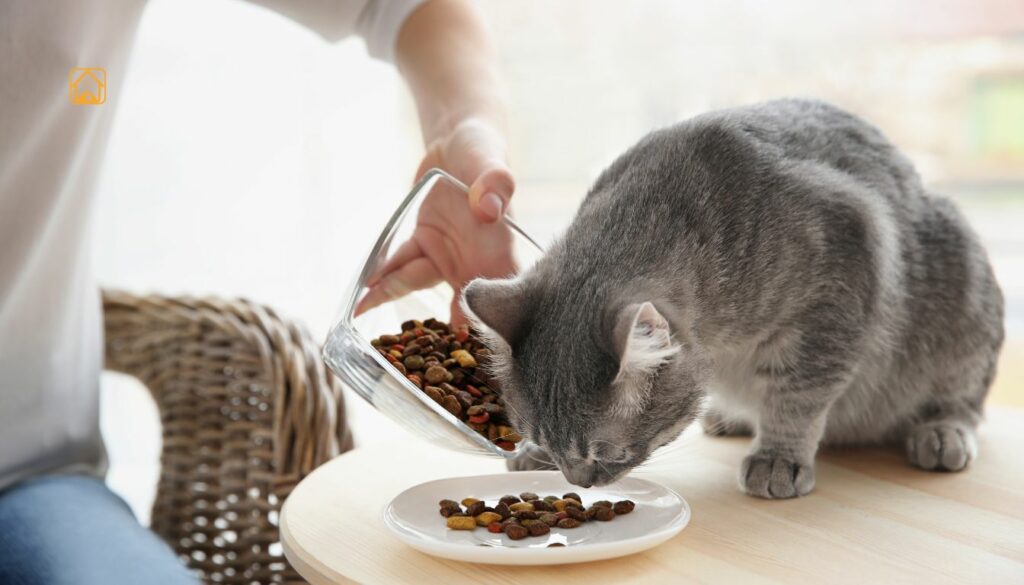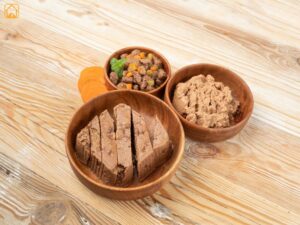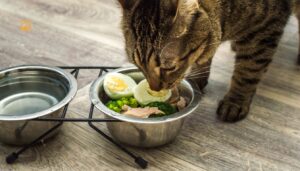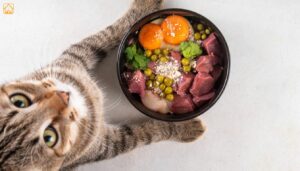Factors That Determine How Much to Feed a Cat
There’s no one-size-fits-all answer to how much to feed a cat. Each cat is unique, and several things shape their daily food needs. Ever tried feeding two cats the same amount, only to see one gain weight and the other stay lean? Yep, that’s cat life. Here’s what matters most:
- Age & Life Stage: Kittens, adults, and senior cats all need different amounts of calories and nutrients. Kittens are little energy machines, while older cats often slow down and need fewer calories.
- Weight & Body Condition: Overweight cats need fewer calories, while underweight or highly active cats may require more. A vet can help you assess your cat’s ideal body condition.
- Activity Level: Couch potato or constant explorer, your cat’s energy use affects their calorie needs.
- Spay/Neuter Status: Spayed and neutered cats typically need fewer calories than intact cats, since their metabolism slows.
- Health Conditions: Issues like diabetes, kidney disease, or thyroid problems can change dietary needs. Always ask your vet for special cases.
- Pregnancy/Lactation: Expecting or nursing moms need extra calories to support their kittens.
I remember thinking my cat was just picky, but it turned out she needed fewer calories after being spayed. Saved us both a few battles at the food bowl.
Understanding Cat Caloric Needs: Calories per Pound Explained
Let’s talk numbers. The magic question everyone asks: How many calories does a cat need? On average, a healthy adult cat needs about 25 to 35 calories per pound of body weight each day. So, a typical 10-pound cat will need 250 to 350 calories daily. But that’s just the starting point.
- Less active or indoor cats: Closer to 20-25 calories per pound.
- Active outdoor cats: Up to 35 calories per pound or more.
- Senior cats: Often need fewer calories, but some need more if they lose weight or have certain health issues.
Calories per pound cat recommendations are guidelines, not rules. Always adjust for your cat’s unique needs, and check with your vet if you’re unsure.
Cat Feeding Chart: Portion Sizes by Weight, Age, and Condition
Sometimes you just want a clear answer. That’s where a cat feeding chart is handy. Here’s a quick look at daily calorie needs and suggested portion sizes for adult cats.
| Cat Weight | Spayed/Neutered (Avg. Needs) | Not Spayed/Neutered (Higher Energy Needs) | Tends to Gain Weight Easily | Needs to Lose Weight |
| 5 lbs (2.3 kg) | Around 125 calories | Up to 175 calories | Close to 100 calories | About 75 calories |
| 8 lbs (3.6 kg) | Around 200 calories | Up to 280 calories | Close to 160 calories | About 120 calories |
| 10 lbs (4.5 kg) | Around 250 calories | Up to 350 calories | Close to 200 calories | About 150 calories |
| 12 lbs (5.4 kg) | Around 300 calories | Up to 420 calories | Close to 240 calories | About 180 calories |
| 15 lbs (6.8 kg) | Around 375 calories | Up to 525 calories | Close to 300 calories | About 225 calories |
| 18 lbs (8.2 kg) | Around 450 calories | Up to 630 calories | Close to 360 calories | About 270 calories |
| 20 lbs (9.1 kg) | Around 500 calories | Up to 700 calories | Close to 400 calories | About 300 calories |
*Portion sizes cat food estimates assume 500 kcal/cup dry or 180 kcal/can wet. Always check your cat food label and adjust as needed.
Honestly, when I first started using a chart, I realized how easy it was to overfeed, especially since my cat’s “hungry eyes” are Oscar-worthy.
How to Calculate Your Cat’s Daily Calorie Requirements
Ready to get specific? Here’s a simple calorie calculator for cats approach you can use at home:
- Weigh your cat (preferably in pounds; 1 kg = 2.2 lbs).
- Multiply their weight by their calorie needs (usually 25-35 calories per pound).
- Factor in age, activity, and if they’re spayed/neutered.
For example, a 8-pound spayed indoor cat: 8 x 25 = 200 calories/day. If your cat is super playful, use 30 instead.
Some pet food brands have online calorie calculators for cats, or your vet can help you fine-tune the number. And don’t forget to include treats, those calories add up fast!
For more on calculating cat calories, visit the online calorie calculator.
Portion Sizes: Measuring Wet vs. Dry Cat Food
Measuring your cat’s food correctly is key to keeping them healthy and avoiding unwanted weight gain. Whether you’re feeding dry kibble or wet canned food, the most important thing to track is the calorie count, not just the volume.
Dry Food: For dry food, always use a standard measuring cup — and never just pour from the bag. Even a small overpour can lead to overfeeding, especially with calorie-dense kibble. A kitchen scale works great if your cat is on a strict diet.
Wet food: This is lower in calories per ounce but contains more moisture, which many cats love. Most cans list calories per serving, so check the label. If you’re feeding part of a can, a digital kitchen scale ensures you’re giving the right amount each time.
Mixing wet and dry food: Just split your cat’s total daily calorie needs between the two types. For example, if your cat needs 250 kcal/day, you might feed 150 kcal from dry and 100 kcal from wet.
Always scoop, never guess. It’s surprisingly easy to overfeed without realizing it. A few extra kibbles daily might not seem like much but over time, they add up.
Feeding Frequency: How Often Should You Feed Adult and Senior Cats?
When it comes to how often to feed a cat, routine is key. Most adult cats do well with two meals a day, spaced about 8-12 hours apart. Senior cats may benefit from smaller, more frequent meals to help with digestion and energy.
Kittens
Kittens under 6 months old usually need 3 to 4 meals a day to support their fast growth. Once they reach 6 to 12 months, you can reduce feeding to 2 or 3 meals a day as their energy needs begin to level out. A feeding guide for adult cat won’t work for kittens, always use kitten-specific charts. Refer to our kitten nutrition guide for more information.
Adult Cats
Most adult cats do well with 2 meals a day, morning and evening. However, some cats prefer 3–4 smaller meals, especially if you’re around or using an automatic feeder.
Senior Cats
Seniors may need fewer calories if less active, but some lose weight as they age. They often benefit from 3–4 smaller meals daily. This gentle routine supports slower digestion and helps reduce stomach issues as they age. Monitor closely, sometimes appetite changes signal health issues.
Overweight Cats
If you’re worried about extra pounds, speak to your vet before cutting portions. Slow, steady weight loss is safest. Try weighing food precisely and track progress weekly.
Pregnant & Nursing Cats
Prenatal and nursing cats need much more, sometimes double their usual calories.
| Stage | Food Type | Daily Quantity (Based on 4–5 kg cat) | Notes |
| Early Pregnancy (Weeks 1–3) | High-quality adult or kitten food | 1.5x normal portion (~60–80g dry or ~1.5 cans wet) | Gradually increase as appetite grows. |
| Late Pregnancy (Weeks 4–9) | Kitten food (dry/wet) | 2x normal portion (~90–110g dry or ~2–2.5 cans wet) | Split into 3–4 meals to reduce stomach pressure. |
| Nursing (Weeks 1–4 postpartum) | Kitten food (dry/wet or both) | 2x–3x normal portion (~100–130g dry + optional wet food) | Needs vary by litter size. free-feeding often works well. |
| Nursing (Weeks 4–8 postpartum) | Kitten food | 1.5x–2x normal portion (~80–100g dry + wet food as needed) | Gradually reduce as kittens begin weaning. |
Free-feeding (leaving food out all day) often leads to overeating and weight gain.
Tips for Creating a Healthy Cat Food Feeding Schedule
- Stick to set meal times, cats thrive on routine.
- Use a measuring cup or scale for every meal.
- Monitor your cat’s weight monthly. Adjust portions if needed.
- Limit treats to less than 10% of daily calories.
- Always provide fresh water. Wet food helps hydration, too.
The best feeding schedule is the one that fits your cat’s needs and your lifestyle. Don’t stress if you need to adjust, cats are adaptable (even if they seem dramatic about it).
FAQ: How much to feed a Cat?
How many calories does a cat need per day?
Most healthy adult cats need 25-35 calories per pound of body weight each day. For a 10-pound cat, that’s about 250-350 calories daily. Factors like age, weight, and activity level can change this number, so check with your vet for a precise amount.
What’s the best way to measure cat food portions?
Use a standard measuring cup for dry food and a kitchen scale for wet food (especially partial cans). Don’t estimate, measuring helps prevent overfeeding and keeps your cat at a healthy weight.
How often should I feed my cat each day?
Most adult cats do best with two meals daily, spaced 8-12 hours apart. Senior cats or those with sensitive stomachs may benefit from 3-4 smaller meals. Kittens should eat even more frequently.
Can I leave food out for my cat all day?
Free-feeding is not recommended for most cats. It often leads to overeating and weight gain. Scheduled meals make it easier to manage portion sizes and track your cat’s appetite and health.
How do I switch my cat’s feeding schedule?
Transition slowly over a week by gradually shifting meal times and portions. Consistency helps cats adjust without stress. If your cat seems upset, give extra attention and stick to the new routine.
What if my cat is overweight?
Work with your veterinarian to create a safe weight loss plan. Don’t reduce food suddenly, instead, measure portions carefully, limit treats, and encourage gentle play. Regular weigh-ins help track progress.
Is wet or dry food better for my cat?
Both can be healthy. Wet food offers more water and supports hydration, while dry food is convenient and can help with dental health. Many owners mix the two. Choose what fits your cat’s health needs and preferences.
Conclusion
Still have questions about how much to feed a cat? Your veterinarian is always the best resource for creating a feeding plan that fits your unique feline friend. A little attention to what’s in the bowl can mean a happier, healthier cat for years to come.



